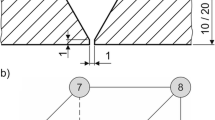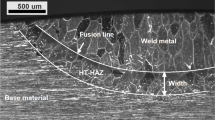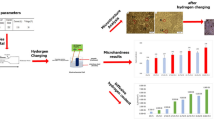Abstract
High-strength low-alloyed (HSLA) steels with yield strength ≥ 690 MPa are gaining popularity in civil engineering and construction of heavy vehicles. With increasing yield strength, the susceptibility for degradation of the mechanical properties in the presence of diffusible hydrogen, i.e., hydrogen-assisted cracking (HAC), generally increases. HAC is a result of the critical interaction between local microstructure, mechanical load, and hydrogen concentration. In existing standards for welding of HSLA-steels, recommendations including working temperatures and dehydrogenation heat treatment (DHT) are given to limit the amount of introduced hydrogen during welding. These recommendations are based on investigations into conventional arc welding processes. In the past decade, modern weld technologies were developed to enable welding of narrower weld seams with V-grooves of 30°, e.g., the modified spray arc process. In that connection, a reduced number of weld runs and weld volume are important technical and, economic benefits. In the present study, the hydrogen distribution in S960QL multi-layer welds with thickness of 20 mm was analyzed. The influence of different weld seam opening angles, heat input, working temperature and DHT were investigated. The results show that weldments with narrow grooves contained an increased amount of diffusible hydrogen. Hydrogen concentration has been reduced by decreasing both the heat input and working temperature. Hydrogen-free weldments were only achieved via subsequent DHT after welding. Furthermore, hydrogen distribution was experimentally determined across the weld seam thickness in HSLA gas metal arc welded multi-layer welds for the first time.












Similar content being viewed by others
References
Ahlblom B, Hansson P, Narström T (2007) Martensitic structural steels for increased strength and wear resistance. Mater Sci Forum 539-543:4515–4520. https://doi.org/10.4028/www.scientific.net/MSF.539-543.4515
Hulka K, Kern A, Schriever U (2005) Application of niobium in quenched and tempered high-strength steels. Mater Sci Forum 500-501:519–526
Gliner RE (2011) Welding of advanced high-strength sheet steels. Weld Int 25(5):389–396. https://doi.org/10.1080/09507116.2011.554234
Rhode M, Steger J, Boellinghaus T, Kannengiesser T (2016) Hydrogen degradation effects on mechanical properties in T24 weld microstructures. Weld World 60(2):201–216. https://doi.org/10.1007/s40194-015-0285-5
Zimmer P, Seeger DM, Boellinghaus T (2005) Hydrogen permeation and related material properties of high strength structural steels. In: High strength steels for hydropower plants, Design Concepts – Pressure conduits: Proceedings of the 3rd International Conference. Verlag der Techn. Univ. Graz, Graz, pp 17-1-18
Fydrych D, Świerczyńska A, Tomków J (2014) Diffusible hydrogen control in flux cored arc welding process. Key Eng Mater 597:171–178. https://doi.org/10.4028/www.scientific.net/KEM.597.171
Pitrun M, Nolan D, Dunne D (2004) Diffusible hydrogen content in rutile flux-cored arc welds as a function of the welding parameters. Weld World 48(1–2):2–13. https://doi.org/10.1007/BF03266408
Schaupp T, Rhode M, Kannengiesser T (2018) Influence of welding parameters on diffusible hydrogen content in high-strength steel welds using modified spray arc process. Weld World 62(1):9–18. https://doi.org/10.1007/s40194-017-0535-9
Boellinghaus T, Hoffmeister H, Schubert C (1995) Finite element analysis of hydrogen distribution in butt joints. In: Trends in welding research, proceedings of the 4th International Conference, Gatlinburg, Tennessee, USA
Mente T, Boellinghaus T, Schmitz-Niederau M (2012) Heat treatment effects on the reduction of hydrogen in multi-layer high-strength weld joints. Weld World 56(7–8):26–36. https://doi.org/10.1007/BF03321362
Steppan E, Mente T, Böllinghaus T (2013) Numerical investigations on cold cracking avoidance in fillet welds of high-strength steels. Weld World 57(3):359–371. https://doi.org/10.1007/s40194-013-0036-4
Wongpanya P (2008) Effects of heat treatment procedures on the cold cracking behaviour of high strength steel welds. Dissertation, BAM-Dissertationsreihe, Band 36
EN 1011-2 (2001) Welding – recommendations for welding of metallic materials – part 2: arc welding of ferritic steels
CEN ISO/TR 17844 (2004) Welding – comparison of standardised methodes for the avoidance of cold cracks
Schaupp T, Schroepfer D, Kromm A, Kannengiesser T (2017) Welding residual stresses in 960 MPa grade QT and TMCP high-strength steels. J Manuf Process 27:226–232. https://doi.org/10.1016/j.jmapro.2017.05.006
Schroepfer D, Kannengiesser T (2014) Correlating welding reaction stresses and weld process conditions for high strength steel S960QL. Weld World 58:423–432. https://doi.org/10.1007/s40194-014-0127-x
Boellinghaus T, Hoffmeister H, Dangeleit A (1995) A scatterband for hydrogen diffusion coefficients in micro-alloyed and low carbon structural steels. Weld World 35(2):83–96
Villalobos JC, Del-Pezo A, Campillo B, Mayen J, Serna S (2018) Microalloyed steels through history until 2018: review of chemical composition, processing and hydrogen service. Metals 8(5):351. https://doi.org/10.3390/met8050351
Zhang L (2017) Microstructure-property relationship in microalloyed high-strength steel welds. Dissertation, BAM-Dissertationsreihe, Band 155
Grabke HJ, Riecke E (2000) Absorption and diffusion of hydrogen in steels. Mater Tehnol 34(6):331–342
Zhang S, Huang Y, Bintang S, Qingliang L, Hongzhou L, Jian B, Mohrbacher H, Zhang W, Guo A, Zhang Y (2015) Effect of Nb on hydrogen-induced delayed fracture in high strength hot stamping steels. Mater Sci Eng A 626:136–143. https://doi.org/10.1016/j.msea.2014.12.051
Cramer H, Baum L, Pommer S (2011) Überblick zu modernen Lichtbogenprozessen und deren Werkstoffübergängen beim MSG-Schweißen. In: DVS-Berichte 275. DVS Media GmbH, Düsseldorf, pp 232–237 (in German)
Norrish J (2017) Recent gas metal arc welding (GMAW) process developments: the implications related to international fabrication standards. Weld World 61(4):755–767. https://doi.org/10.1007/s40194-017-0463-8
EN 10025-6 (2011) Hot rolled products of structural steels - part 6: technical delivery conditions for flat products of high yield strength structural steels in the quenched and tempered conditions
EN ISO 16834 (2012) Welding consumables - wire electrodes, wires, rods and deposits for gas shielded arc welding of high strength steels - classification
Siebertz K, van Bebber D, Hochkirchen T (2010) Statistische Versuchsplanung - design of experiments (DoE). Springer-Verlag, Heidelberg
EN ISO 3690 (2017) Welding and allied processes - determination of hydrogen content in arc weld metal
Rhode M (2016) Hydrogen diffusion and effect on degradation in welded microstructures of creep-resistant low-alloyed steels. Dissertation, BAM-Dissertationsreihe, Band 148
Salmi S, Rhode M, Jüttner S, Zinke M (2015) Hydrogen determination in 22MnB5 steel grade by use of carrier gas hot extraction technique. Weld World 59(1):137–144. https://doi.org/10.1007/s40194-014-0186-z
Rhode M, Schaupp T, Muenster C, Mente T, Boellinghaus T, Kannengiesser T (2018) Hydrogen determination in welded specimens by carrier gas hot extraction – a review on the main parameters and their effects on hydrogen measurement. Weld World 1–16. https://doi.org/10.1007/s40194-018-0664-9
Fine-grain structural steels—MAXIL 960—high-strength, water quenched and tempered. http://www.ilsenburger-grobblech.de/fileadmin/mediadb/ilg/infocenter/downloads/werkstoffblaetter/feinkornbaustaehle_maxil960.pdf. Accessed November 2018
Kannengiesser T, Schroepfer D (2016) Use of modified spray arc processes for optimization of welding loads in components of high-strength structural steels. Final report of Research Project IGF 16557N (in German)
Boellinghaus T, Mente T, Wongpanya P, Viyanit E, Steppan E (2016) Numerical modelling of hydrogen assisted cracking in steel welds. In: Boellinghaus T, Lippold JC, Cross CE (eds) Cracking phenomena in welds IV. Springer International Publishing, Cham, pp 383–439. https://doi.org/10.1007/978-3-319-28434-7_18
Schroepfer D, Kromm A, Kannengiesser T (2015) Improving welding stresses by filler metal and heat control selection in component-related butt joints of high-strength steel. Weld World 59:455–464. https://doi.org/10.1007/s40194-014-0219-7
Schaupp T, Kannengiesser T, Burger S, Zinke M, Juettner S (2017) Determination of suitable heat control to avoid hydrogen-assisted cracking during welding of high-strength structural steels with modified spray arc. Final report of research project IGF 18596 BR (in German). urn:nbn:de:kobv:b43–425946
Abe M, Nakatani M, Namatame N, Terasaki T (2012) Influence of dehydrogenation heat treatment on hydrogen distribution in multi-layer welds of Cr-Mo-V steel. Weld World 56(5):114–123. https://doi.org/10.1007/bf03321355
Kasuya T, Hashiba Y, Ohkita S, Fuji M (2001) Hydrogen distribution in multipass submerged arc weld metals. Sci Technol Weld Joi 6(4):261–266. https://doi.org/10.1179/13621710110153876
Acknowledgements
Thanks are given for support of the representing companies actively involved in the project board. Authors also thank Harald Goetsch, Marina Marten and Mareike Kirstein for their assistance in sample preparation and treatment.
Funding
The present contribution was a part of the AiF-project IGF-No. 18.596 BR / DVS 01.088 of the Research Association on Welding and Allied Processes of the DVS. It was kindly funded by the German Federal Ministry for Economic Affairs and Energy (BMWi) by the AiF (German Federation of Industrial Research Associations) as part of the program for support of the Industrial Cooperative Research (IGF) on basis of a decision by the Deutscher Bundestag.
Author information
Authors and Affiliations
Corresponding author
Additional information
Recommended for publication by Commission II - Arc Welding and Filler Metals
Rights and permissions
About this article
Cite this article
Schaupp, T., Rhode, M., Yahyaoui, H. et al. Influence of heat control on hydrogen distribution in high-strength multi-layer welds with narrow groove. Weld World 63, 607–616 (2019). https://doi.org/10.1007/s40194-018-00682-0
Received:
Accepted:
Published:
Issue Date:
DOI: https://doi.org/10.1007/s40194-018-00682-0




